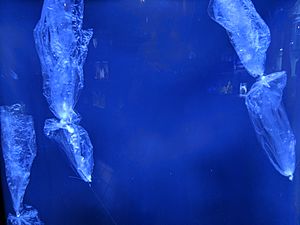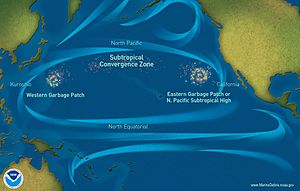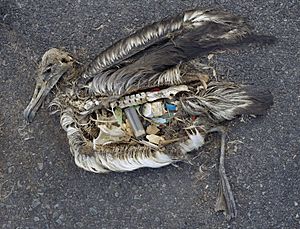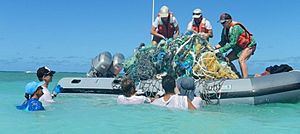Marine plastic pollution facts for kids
Marine plastic pollution is when plastic trash ends up in the ocean. This plastic can be big, like bottles and bags, or super tiny, like microplastics and nanoplastics. About 80% of all the trash in the ocean is plastic.
Plastic floating in the ocean is very bad for ocean animals and plants. Animals can get tangled in it or choke on it. If they eat or breathe in small pieces of plastic, it can hurt their insides.
The top ten countries that put the most plastic into the ocean are China, Indonesia, the Philippines, Vietnam, Sri Lanka, Thailand, Egypt, Malaysia, Nigeria, and Bangladesh. Most of this trash flows into the ocean through rivers connected to these countries.
Unlike many other things, plastics do not break down naturally (they don't biodegrade). They can break down into smaller pieces when exposed to the sun (this is called photodegradation), but only under certain conditions.
Some companies are trying to help by changing how they make and package their products. There are also many ideas for cleaning up the plastic already in the oceans. These ideas include catching plastic at river mouths before it reaches the ocean and cleaning up the big areas of plastic in the ocean gyres.
How Big is the Problem?

A lot of the plastic we use every day is not recycled. Up to 90% of it might end up in the ocean. Scientists believe there are about 15 to 51 trillion pieces of plastic in the ocean right now.
It is thought that 9 million tons of plastic enter the ocean every year. Experts estimate that if this continues, there will be more plastic (by weight) than fish in the ocean by the year 2050. Ocean currents carry plastic and other trash very far. Sometimes, plastic from distant places can be found on the beaches of faraway islands.
Microplastics
The biggest danger from ocean plastic pollution comes from microplastics. These are tiny bits of plastic, usually smaller than 0.195 inches (about the size of a sesame seed). Sometimes, microplastics are made to be small on purpose, like the microbeads once found in some soaps. Other times, microplastics form from larger pieces of plastic that break down due to sun and weather.
Harmful effects of microplastics
Microplastics are often eaten by very small ocean creatures at the bottom of the food chain, like plankton and baby fish (larvae). Then, bigger animals eat these smaller creatures, and the microplastics move up the food chain. Sometimes, humans eat fish that have eaten smaller fish with microplastics, which means we can take in these tiny plastic bits and their chemicals too.
Microplastics can build up in the gills and intestines of ocean animals. This makes it hard for them to breathe and eat, and it can even kill them. Many studies have found plastic and microplastics inside the stomachs of marine animals.
As plastics break down in the sun, they can release harmful chemicals like bisphenol A, PCBs, and parts of polystyrene. These chemicals can cause many health problems in humans and animals when we eat, drink, or breathe them in. Some problems include harming the endocrine system, weakening the immune system, reducing fertility, confusing the central nervous system, and irritating the gastrointestinal tract.
Macroplastics
Macroplastics are larger pieces of plastic waste that have not yet broken down into smaller bits. Examples of macroplastics include water bottles, plastic food packaging, and plastic bags.
Harmful effects of macroplastics
Larger plastic waste can be eaten by ocean animals and birds. The plastic fills their stomachs, making them feel full even though they haven't gotten any food or nutrients. This can cause them to die from starvation. In March 2019, a dead Cuvier's beaked whale washed ashore in the Philippines with 88 pounds of plastic in its stomach.
Ocean animals can also get tangled in larger pieces of plastic. This can lead to them starving, suffocating, or being killed by predators because they can't move or escape.
Where Does All the Plastic Come From?
The largest single type of plastic pollution (about 10%) and most large plastic in the oceans comes from fishing nets that have been lost or thrown away by the fishing industry. Many merchant ships and cruise ships also dump trash like cargo, sewage, used medical equipment, food packaging, and other plastic waste into the ocean.

Sometimes, plastic items are made on land and then dumped into the ocean by ships. Other times, plastic enters the ocean because it has been thrown into rivers from land, and these rivers flow into the ocean. Landfills are another source that worries scientists.
A study in 1994 looked at the seabed (the ocean floor) in the North-Western Mediterranean near Spain, France, and Italy. It found an average of 1,935 pieces of trash per 0.386 square miles (1 square kilometer). 77% of this trash was plastic, and 93% of that plastic was plastic bags.
One study estimated that there are more than 5 trillion plastic pieces (including small microplastics, large microplastics, and bigger pieces) floating in the sea. In 2020, Australia's national science agency CSIRO estimated that 14 million metric tons of microplastics are already on the ocean floor. Another study in 2020 showed that there was 10 times more plastic in the Atlantic Ocean than previously thought.
Where Plastic Collects
Plastic in the ocean follows ocean currents, which eventually form into what are called Great Garbage Patches. The most famous one is the Great Pacific garbage patch. It is believed to be huge, possibly twice the size of Texas. Other patches include the North Atlantic garbage patch, the South Atlantic garbage patch, the South Pacific garbage patch, and the Indian Ocean garbage patch.
Research and Studies
Scientists are still studying microplastic pollution in the deep sea. They are looking at the plants, animals, and sea floor at great depths to understand the problem better. They are finding microplastics in the deep sea and inside the animals that live there.
What Can We Do to Help?
We can reduce the amount of plastic that pollutes the ocean by:
- changing how companies package products,
- collecting plastic that is already in the ocean, and
- reusing plastic waste as something else (recycling).
In 2019, a group of scientists at Washington State University found a way to turn plastic waste into jet fuel. Blest Co. Ltd. also created technology that can change plastic waste into valuable liquid fuels like gasoline, diesel, and kerosene.
Government agencies are also encouraging people to be careful with how they use plastic. Some of these agencies include the EPA, the National_Park_Service, the USDA, the FDA, and the DOE.
See also
 In Spanish: Contaminación marina por plástico para niños
In Spanish: Contaminación marina por plástico para niños
Images for kids
-
Washed-up plastic waste on a beach in Singapore
-
Sea turtle entangled in a ghost net
-
Northern gannet on Helgoland, trapped in their own nests, built only of old nets and other plastic waste.
-
The remains of an albatross containing ingested plastic trash.








